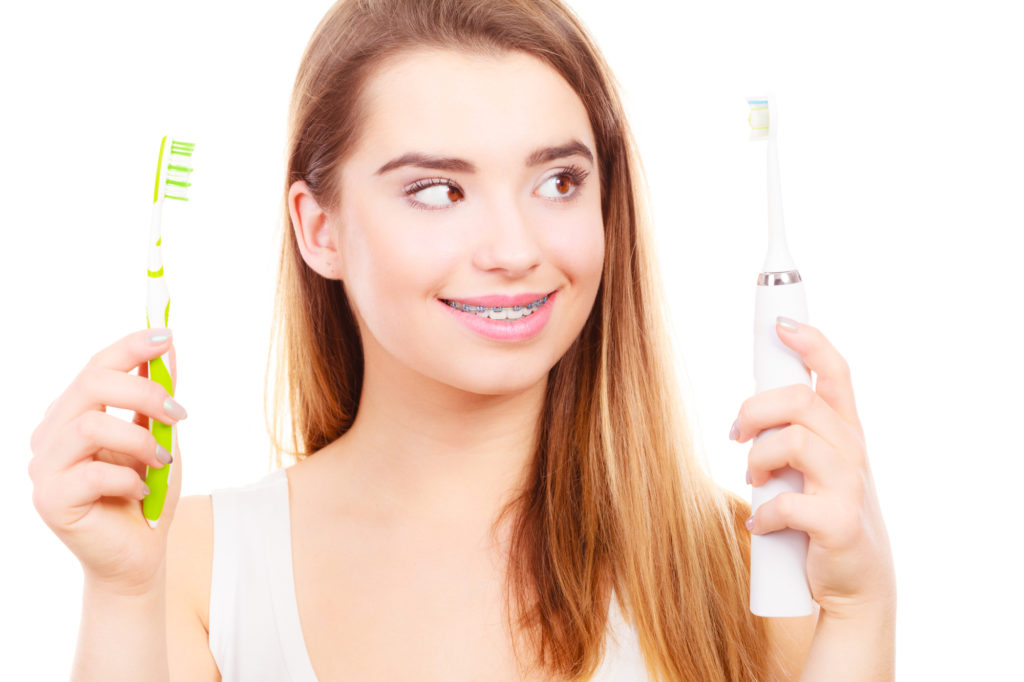
Do you sometimes find it hard to keep your braces clean with regular brushing and flossing? It can be tricky to thoroughly brush and floss during orthodontic treatment. But it is vital for the health of your teeth and the success of your treatment to keep your teeth and braces clean. One great option to consider is an electric toothbrush.
Is an Electric Toothbrush Safe?
Electric toothbrushes are safe for use with braces. Just like your teeth, your braces are pretty tough. They will stand up to the nylon bristles of both manual and electric toothbrushes. And because electric toothbrushes brushes move extremely fast, they are designed with oral health, including that of your teeth and the soft tissue of your gums, in mind. Your metal braces will hold up to an electric toothbrush that is safe for normal brushing. Look for a toothbrush with the ADA seal, meaning it has undergone clinical trials for effectiveness and safety.
Is an Electric Toothbrush More Effective?
Clinical studies show that electric toothbrushes are more effective during orthodontic treatment. Depending on the type of electric toothbrush you choose, it can rotate anywhere from 2,500 to 30,000 strokes per minute. Even the lowest end of that range is more than you can do on your own with a manual toothbrush.
In addition, electric toothbrushes are able to better clean the area between the teeth as well as all the tiny spaces around your braces. A task that can be hard to accomplish with your regular toothbrush. Additional features, such as sensitivity settings and timers, offer another advantage.
Keep in mind that you can maintain good oral health with your manual toothbrush, even during orthodontic treatment. The most important factors are brushing 2-3 times per day for at least two minutes, using a soft-bristled brush, holding your brush at a 45-degree angle towards your gums, and, of course, flossing. Good brushing habits with any toothbrush are essential to keeping teeth and braces clean. But the evidence suggests an electric toothbrush can boost these habits for an even healthier smile.
Flossing Aids
In addition to choosing an electric toothbrush, there are some other recommendations for oral hygiene with braces. Flossing can be a hurdle when under orthodontic treatment. Braces as simply in the way, making it difficult to get between the teeth.
Floss Threader
One option for better flossing with braces is to thread the floss between the wire and your tooth to get closer to the gums. This can be time-consuming and frustrating. A tool called a floss threader makes it much quicker and easier.
Waterpik
Another option is called a “Waterpik,” also known as an oral irrigator or water flosser. This tool uses a tiny stream of water to clean between your teeth. It can also be highly effective at cleaning around the brackets of your braces.
Soft Gum Pick
Soft gum picks are similar to toothpicks, but they are sized to get between teeth and, as the name suggests, are made of a soft, flexible material. These picks are designed to get between teeth, similar to flossing, as well as clean the gum line. They are also ideal for cleaning debris from braces.
Bottom Line
You should choose a toothbrush and flossing option that you are comfortable and happy with. The most important thing is to brush regularly and thoroughly, so using the tools that help you to do that is crucial. Remember, the best oral hygiene tool is the one that allows you to clean easily and comfortably.
Make sure to schedule your regular appointments with our office to get the most out of your treatment. If you have any questions or are having trouble keeping your teeth and braces as clean as you would like, ask your orthodontist for recommendations at your next appointment.





